Turkey coalmine disaster: accident or murder?
- May 14, 2014
Capitalism & Crisis
The explosion that killed hundreds of coalminers in Turkey was not a random accident; it was the direct consequence of a decade of neoliberalization.
- Author
Not even two months ago you could hear Turkey’s urban middle class and youth shouting “thieves!” (hirsiz var!) at a corrupt elite in the Turkish government that illegally enriches itself. Today, as Twitterers report, we hear protesters chant “murderers!” (katiler!) in front of the Istanbul offices of Soma Holdings, the private owner of the lignite mine in Turkey’s Soma district, which just became a death trap to hundreds of coalminers.
While fellow miners, family members and other townsfolk are still digging desperately for survivors after yesterday’s explosion and fire inside the mine, riot police had their hands full washing people away with their water canons in the street where the Soma Holdings offices are located.
As I write this, Turkish news agencies officially report 274 deaths. But earlier today, Energy Minister Taner Yildiz stated that 787 people were working in the mine at the time of the explosion. It seems that there were more miners inside than usual since the explosion occurred during a change of shifts. So it is feared that more than 400 miners are still trapped underground, which runs as deep as 2 kilometres. Those trapped inside run the risk of carbon monoxide poisoning, so time is crucial and rescue teams are pumping oxygen into the mine.
Fire was still blazing inside 18 hours after the blast, and with another fire that reportedly started in the ventilation area, this is a very tricky rescue operation — if it is not already too late. Dozens of ambulances are waiting. 76 injured have been already hospitalized. In recent hours, only dead bodies on stretchers have been brought back from the shaft. The reported death toll already surpasses the 263 victims of Turkey’s worst mining disaster to date, following a gas explosion in a mine in the Black Sea port of Zonguldak in 1992.
An “unfortunate tragedy”
Naturally, the Soma mining company issued a statement that this “tragic accident” is highly unfortunate. Officially, the cause was first reported as an electrical fault causing power failure, but news reports have corrected this by quoting expert mining engineers at the scene who say that an explosion in an electric underground transformer or in a command room had blown up a power distribution unit, which now disables workers from using the mine’s elevators and its ventilation system.
Also “naturally”, but regrettably, responsibilities a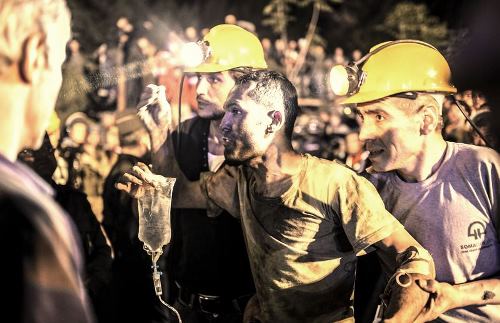 re already being pushed onto others. In the media, fingers were quickly pointing to different parties and in the political arena yet another polemic battle has begun. The main opposition party CHP points fingers to the ruling AKP, reminding people of their recent call for a safety inspection at the mine during a parliamentary inquiry. This call was rejected by the AKP only two weeks ago, on April 29. A leading voice on this matter is Özgür Özel, the deputy of Manisa — the province in which Soma is situated — who was then seen waving with a yellow hard hat in Parliament. An AKP member from Manisa, Muzaffer Yurttas, denied the urgency of the motion by claiming that the mines were safer than in most other countries around the world.
re already being pushed onto others. In the media, fingers were quickly pointing to different parties and in the political arena yet another polemic battle has begun. The main opposition party CHP points fingers to the ruling AKP, reminding people of their recent call for a safety inspection at the mine during a parliamentary inquiry. This call was rejected by the AKP only two weeks ago, on April 29. A leading voice on this matter is Özgür Özel, the deputy of Manisa — the province in which Soma is situated — who was then seen waving with a yellow hard hat in Parliament. An AKP member from Manisa, Muzaffer Yurttas, denied the urgency of the motion by claiming that the mines were safer than in most other countries around the world.
Today, Prime Minister Erdogan shrugs off the criticism by stating that accidents can happen and that the opposition only raised the issue to obstruct his parliamentary agenda. The Prime Minister then repeated a statement by the Ministry of Labor and Social Security that inspections had been carried out regularly, and most recently on March 17. At that point, the mine was found to comply with Turkey’s safety regulations. Erdogan also referred to the British and American history of mine disasters in the 19th and early 20th centuries in an attempt to normalize the accidents. But he assured citizens that the situation would be carefully investigated: “No stone will be left unturned.”
A deeper, more systemic problem
Despite the Prime Minister’s promises and historical justifications — which was met by a booing and whistling crowd outside Soma’s municipal offices — critical voices suggest a deeper, more systemic problem at the heart of the relationship between heavy industry and the state. Workers accuse the top of the Soma Komur Isletmeleri A.S. for the unsafe work conditions. More worrying is the news report on CNN Turkey of a survivor, Özcan 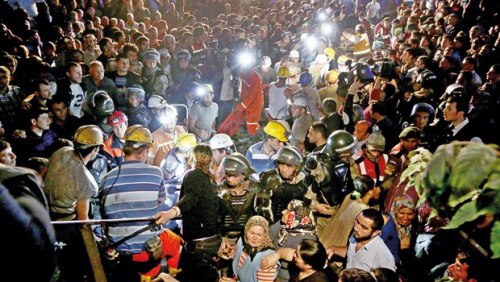 Cüce, who accused a supervisor of giving the wrong directions to trapped miners, leading them away from the oxygen supply. Most importantly, he stated:
Cüce, who accused a supervisor of giving the wrong directions to trapped miners, leading them away from the oxygen supply. Most importantly, he stated:
This is not something that suddenly happened. I can tell you that there are people here who are dying, people who are injured and it’s all because of money … They send us here like lambs to slaughter. We are not safe doing this job.
A recently trending hashtag #kazadegilcinayet (“murder, not an accident”) turns this criticism into a straightforward indictment. The English section on sendika.org also does not beat around the bush with the following headline: “On Tuesday, May 13, at 15.00, Turkey witnessed one of the greatest workplace murders in its history.”
Surely the tightening connections between privatized industry and neoliberal government in Turkey have had a highly noxious influence on worker safety. Soma, a district with a population of around 100.000 citizens, is a significant centre for lignite coal mining with its own lignite-fired thermal power plant. Turkey still has rich supplies of hard coal and low-grade lignite resources, which are extracted for domestic power generation. Earlier this month, on May 3, in the Daily Sabah, the Energy Minister boasted that Turkey was investing $118 billion by 2023 to meet the country’s doubling energy consumption. And, not much earlier, it was noted that Turkey’s position in world energy markets is rapidly increasing.
Privatization and deregulation
The leading Justice and Development Party (AKP) has complemented these investments with privatization, deregulation and wage reductions in order to keep Turkey’s mines profitable and attractive to Western capital. As part of this strategy, costs are reduced by loosening safety procedures, creating “flexible” work conditions, lowering the standards for training, and subcontracting unskilled or even unregistered under-age workers. In 2005, the fatality of a 17-year-old in Zonguldak revealed that under-age mineworkers — although not legal according to Turkish law — remain a chronic problem because of poverty and lack of free education. The youngest known victim at Soma, Kemal Yildiz, was only 15 years old.
Moreover, it has now been reported that the average monthly wage for miners is only 500 dollars. And due to weakened safety in the lignite mines, accidents have sadly become facts of daily life. The Soma Holding is part of the government’s privatization drive and, according to Hürriyet reporter Murat Yetkin, the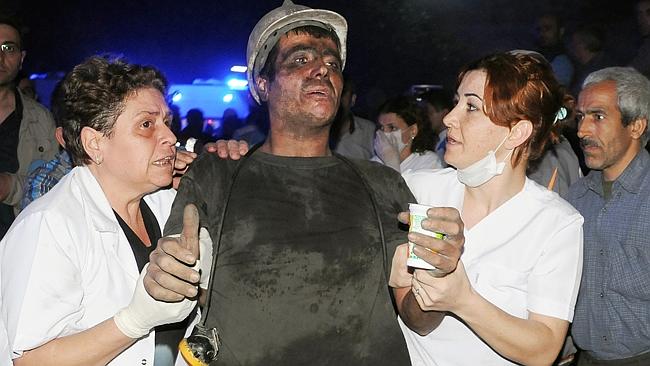 owner of the mine, Ali Gurkan, had boasted earlier about how much costs had been cut after the mine was privatized.
owner of the mine, Ali Gurkan, had boasted earlier about how much costs had been cut after the mine was privatized.
The problem is not only with the privately-owned mines, though. A report by the General Miners Union in March 2010 stated that, between 2000 and 2009, 25.655 accidents had occurred in the state-owned mines of the Turkish Coal Corporation (TTK), and that 98 percent could have been prevented if only the problems of insufficient safety inspections and training had been properly addressed. But the government took little or no action.
What’s more, parent company Soma Holding Mine Enterprises is known to have enjoyed close ties with the ruling AKP ever since 2005. The General Director’s wife, for instance, is the regional councillor for the AKP. Ironically, Soma Coal was the provider of the charity coal bags, distributed by the AKP during local elections to recruit support amongst the local poor.
No random accident
Soma’s latest tragedy does not seem to be a random accident caused by workers’ negligence: it is emblematic of a wider problem that is systemic and intrinsic to Turkish industry and the neoliberal policies of Erdogan’s AKP government, as much as of a global market economy in which Turkey is trying to raise its profile. Just as the Prime Minister openly cites other nations’ grim labor histories, workers in Turkey are today yet again treated as “natural casualties” for a higher purpose.
The intent behind such reasoning is nauseating. An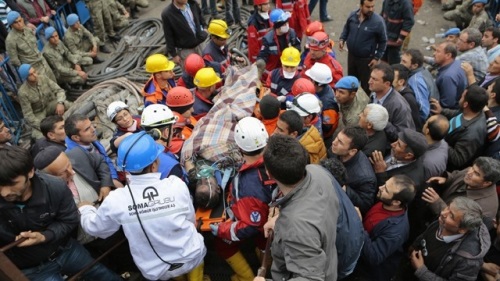 d there is an even grimmer consideration to this, provided by Çetin Uygur (DISK), who was one of the first to say that this was the greatest workplace massacre in the history of the Turkish working class. Uygur stated that the AKP government was sending large numbers of military troops and police forces to the region, not to assist in the rescue but to suppress widespread dissidence. One could also see the Prime Minister’s declaration of three days of national mourning, marked by half-staff flags, as an attempt to keep announced protests and boycotts under control.
d there is an even grimmer consideration to this, provided by Çetin Uygur (DISK), who was one of the first to say that this was the greatest workplace massacre in the history of the Turkish working class. Uygur stated that the AKP government was sending large numbers of military troops and police forces to the region, not to assist in the rescue but to suppress widespread dissidence. One could also see the Prime Minister’s declaration of three days of national mourning, marked by half-staff flags, as an attempt to keep announced protests and boycotts under control.
So there has been a lot of pointing in many directions; yet not a single MP or government minister has resigned. Heartfelt condolences by politicians cannot make up for the hundreds of unnecessary deaths, or the billions that are being made on the back of people’s labor, while charity coal bags are distributed to keep the same government in power. Critics outside of Turkey are quick to speculate whether this recent mine explosion will explode Turkey’s precarious social and political situation. If Erdogan knows his history, he also knows that working class labor calamities are always a reality check on the state of political power. With the volatile social climate in Turkey after this summer’s wave of Gezi protests, it has been noted many times before that a blue-collar uprising could be the tipping point — something that has so far been avoided.
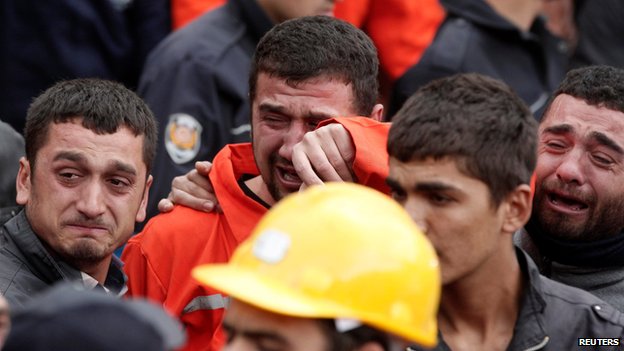 Student protests in Ankara and Istanbul have already started in anticipation of the one-day strike announced by the major trade unions (DISK, KESK and TMMOB) for Thursday, May 15. A march was held in Ankara from the Middle Eastern Technical University (ODTÜ) to the Energy Ministry. In Istanbul, young protesters were spotted on Taksim Square and in the metro station lying on the floor, representing the dead in the mine. Thousands gathered this evening at a solidarity demonstration in Istanbul’s busy Istiklal street, which quickly turned into an anti-government protest that was mercilessly attacked by hundreds of riot police firing tear gas and rubber bullets at the crowds alongside half a dozen TOMA water cannons.
Student protests in Ankara and Istanbul have already started in anticipation of the one-day strike announced by the major trade unions (DISK, KESK and TMMOB) for Thursday, May 15. A march was held in Ankara from the Middle Eastern Technical University (ODTÜ) to the Energy Ministry. In Istanbul, young protesters were spotted on Taksim Square and in the metro station lying on the floor, representing the dead in the mine. Thousands gathered this evening at a solidarity demonstration in Istanbul’s busy Istiklal street, which quickly turned into an anti-government protest that was mercilessly attacked by hundreds of riot police firing tear gas and rubber bullets at the crowds alongside half a dozen TOMA water cannons.
Yet the grimmest image that screams for defiance is described by some of the rescue workers: because of a shortage of cold storage space in one of the town’s slaughterhouses that stands as a temporary morgue, dead bodies are now being brought to the hospital with oxygen masks attached to their faces. In a politically suffocating climate where gas masks have gained such symbolic meaning, the muted faces of the dead behind these gas masks express so much more than any protest ever could.
Source URL — https://roarmag.org/essays/turkey-soma-coalmine-disaster/

